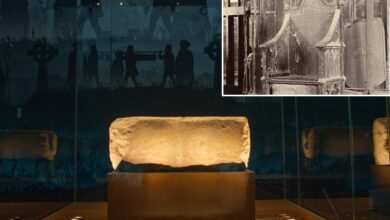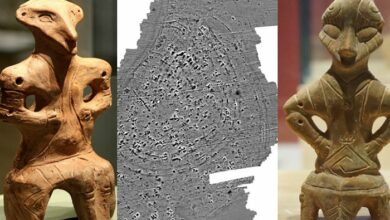Exciting Find In The Swiss Alps – First Furrows And Animal Tracks Are Evidence Of Prehistoric Plowing

Conny Waters – AncientPages.com – An exciting find in the Swiss Alps has been unearthed: soil layers dating back 7,000 years, intriguingly filled with unexplained furrows and animal tracks.
Goat and domestic cattle hoofprints in depression 365 at the surface of AG1 – Photographs: ARIA SA.
This extraordinary discovery by a global team of archaeologists and scientists has revolutionized our perception of Stone Age farming practices in Europe. Their research at the Anciens Arsenaux excavation site in Sion, Valais, Switzerland, reveals that Stone Age farmers used animals to pull plows as far back as between 5,100 and 4,700 BC.
This finding significantly alters our understanding of early agricultural techniques, and indicates that the first furrows in Europe are around a thousand years older than we initially believed. Until now, the most ancient plow marks were believed to be from around 3700 BC, discovered in Denmark and northern Germany.
Model (painted wood) of a Man Plowing dated to Egypt’s Middle Kingdom Period – early to mid-Dynasty 12 – ca. 1981–1885 B.C. Credit Line: Gift of Valdemar Hammer Jr., in memory of his father, 1936
The study doesn’t just uncover the earliest documented use of plows in Europe – it also implies that we may need to rethink our entire understanding of Early Stone Age agriculture.
In Switzerland, the archaeological evidence of ancient plowing is marked by prominent, distinct furrows. However, discoveries of such old plow tracks are quite uncommon due to their delicate nature. They are easily affected by erosion or following agricultural activities.
The furrows were luckily preserved due to a rapid sediment cover from a close stream that likely breached its boundaries. As a result, these imprints have been conserved within the layers of soil.
“Plough marks are the most tangible, widespread and convincing evidence. They consist of linear depressions filled with sediment of a different texture and colour than that of the surrounding deposits. Such marks can be followed over dozens of meters to form parallel or criss-crossing networks. They imply the use of a specific tool, the ard and its traction by a powerful animal such as an ox,” the researchers wrote in their study published in the journal Nature.
Map showing the location of the Anciens Arsenaux site (Sion, canton of Valais, Switzerland; yellow dot) and European sites with traces of ploughing dating from before 2000 cal BC (red dots). Source
Carbon-14 testing of organic materials found in various soil layers of the old fields revealed that the examined furrows are relics from the Neolithic period (or Stone Age), specifically around 5100-4700 BC.
The researchers didn’t just discover plow marks; they also stumbled upon hoof prints believed to be from oxen and goats. These were found along the same route as the plow tracks, leading researchers to believe that Stone Age people likely employed both oxen and goats to haul their plows.
Earlier discoveries of animal bones in Anatolia and the Balkans have long suggested the use of cattle or oxen for traction around 6,000 B.C. but these were merely speculations.
This is indeed the first solid archaeological proof confirming extensive plowing in Europe. The use of animals in agricultural works has its beginning long time ago.
See also: More Archaeology News
However, the plowing practice discussed in the study strongly contradicts the old theories of a slow and gradual build-up of agriculture. Considering the latest plowing evidence, the Stone Age agricultural societies were seemingly wealthier and more advanced than we previously thought.
The study is published in Nature.
Written by Conny Waters – AncientPages.com Staff Writer







